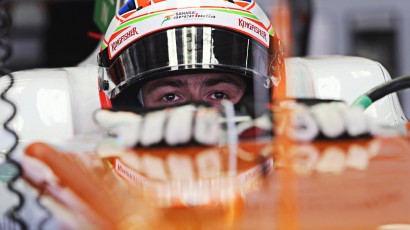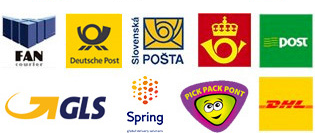Team Sahara Force India

"I’ve got every watch that means something to me. I’ve worn a lot of watches -- a lot of good watches -- throughout my career."
Watches and F1 have always gone hand in hand. Timekeeping is integral to the sport, and watchmakers have always vied to be partnered with winning teams. The latest union on the racetrack is between big, bold brand TW Steel and the upstart Sahara Force India Formula 1 team. TW Steel, known internationally for its oversize watches, is using this weekend's race at Silverstone to launch its collection of six new timepieces, Sahara Force India Pilot Editions. We got a sneak peek at the watches and talked about horology and racing with Sahara Force India drivers Adrian Sutil and Paul Di Resta.
Do you have an extensive collection of watches?
Paul Di Resta (PDR): Yeah, I’ve have a few -- I’ve known the TW Steel guys since I got into Formula 1. It’s obviously an exciting, young, fresh brand. Hopefully there’s big things ahead.
Adrian Sutil (AS): I have a few watches -- I like changes in my life.
Do you have a favorite watch in the collection?
AS: I’m wearing the Coulthard [both drivers laugh as they realize they have on the same watch -- David Coulthard CEO Tech Edition]. I chose it because I liked the design.
Photo: James Moy Photography
Do you have different watches for different occasions?
PDR: Yes, I do, and obviously I’ve got more than most people based on the fact that TW Steel is my team sponsor. Watches are a great passion of mine. They’re one of those things that I like to collect. Any watch that I use I never like to get rid of. They very much become part of my life and my journey, and I think it’s one of those things that you should keep. I can’t keep my car, so some of the next best things are my helmets and the stuff that I wear out of the paddock.
Why did you get into watches?
PDR: To tell the time at school... to know when to get out of it.
Do you still have any of those?
PDR: I’ve got every watch that means something to me. I’ve worn a lot of watches -- a lot of good watches -- throughout my career. It’s one of the things that become a trophy and a memento from a result. The watches that I wear today will always be a part of what I was at Sahara Force India.
Timekeeping is an essential part of the sport. Do you remember first lap times?
PDR: Yeah, I’ve got books and books keeping track of every lap I’ve ever done from when I started carting. My dad and my mechanic used to write them down and write them down and write them down. It’s quite cool to actually pull these books out.
What do you think of the new tracks that have come online in the recent years?
PDR: There are great tracks in the world and you never want them taken off Formula 1, but there are tracks that need to be replaced with better ones. We also enjoy new tracks because otherwise it gets a bit stagnant and drivers learn the tricks of the trade. Being the young one, you like to see the new tracks part of it.
It’s difficult when you’re trying to get in -- you’re trying to push the old drivers out. Trying to make sure your services are more exceptional than your competitors. But you’ve still got to hold respect for everybody.
AS: I still like the old circuits on the calendar but in life it’s nice to change. It’s not good if you just standstill and there’s no development. The new circuits are safer. I like the old circuits and I like the new circuits -- the mixture is quite nice right now.
Can you push harder on the newer tracks?
AS: Of course -- you can push it earlier to the limit. There are no walls, lots of run-offs -- you can go wide. The mixture is quite nice -- you go to Monaco and it’s not like that. You get penalties when you go a bit too fast -- you’ll go into the wall and you destroy the car. But then, of course, then you have to evaluate what’s more important: Is it safety or is it going close to the walls and knowing where the limit is? Sometimes I have to say the modern ones, they’re too safe. Wherever you go, you almost can’t hit the barrier. You know, in Bahrain, sometimes the run-off areas are just massive -- you get lost.
It’s also not the reason of racing. Our profession is to drive a race car on a circuit as fast as possible, and sometimes it’s easy -- too easy -- to drive on these circuits because there’s no penalties if you go over the limits.
The sport has changed over the years, hasn’t it? There seems to be a bit less focus on the cars and more focus on drivers now.
AS: Racing is more interesting now. A lot of teams have a chance at winning or at least finding a spot on the podium. It’s not all about money -- you also need the ideas behind a good race team. Of course, you need the right equipment, so you need a certain budget, but you also need quality people. Sometimes even with a lot of money, you get lost in it all and you won’t make it. Toyota tried very hard with a big budget and they didn’t make it. We have a small budget -- I wouldn’t say we’re a very small team -- we are a smaller team and we do quite well. To take the next step, we probably need to double everything. That’s the hard part -- the last little half a second or so.
Photo: James Moy Photography
The technology gaps aren’t that big anymore, but to find two-tenths is very, very hard. That’s why in the race tires dominate sometimes, and if we have a good setup and the tires last longer than the other teams, then suddenly we can be on the podium. That wasn’t the case many years ago. The pure, fastest car won the race, and it was always the same drivers. I think it’s much more interesting now. We go on the circuit and there’s a feeling that anything is possible.
PDR: Tires are a key thing. Drivers can influence that a lot this year with how much they use their right foot. How heavy do you want to be with it at certain points in the race? It brings that skill factor into it. I certainly don’t want to be driving with no fear that the tires aren’t going to drop off -- it makes it fun and it makes it fun for the fans.
Photo: James Moy Photography
What’s the difference between an F1 driver and and an everyday driver?
AS: We have reaction times that are maybe a bit quicker than everyone else. We probably have a little bit better orientation. When I drive on roads, I see things that other people don’t see. I don’t need to look left and right -- I already see it coming.
To go fast, you need the talent -- and your fear shouldn’t be too high.
When did you know wanted to be driver?
AS: I started racing when I was 13, and I just knew that it was something I could do very well. I’m a competitive person. I trained hard. I wanted to become the best. I moved my way up through different categories. I wouldn’t say I’m the best driver -- I’m always trying to be the best driver. I’m always learning. If you realize that you are the best, then you should find something else. The challenge always needs to be there.
What do you think was the biggest thing that helped you become an F1 driver?
AS: My attitude. Since I was young, I liked speed and competition. It was not an easy way up, but I met a lot of people who all helped me a little bit. It was like small little pieces, like a puzzle, for my future career, my success. I still haven’t reached my goals, so it’s still going on. Without the right attitude, you can’t do this sport. You need to wake up and always have this power and this energy. I’m obsessed with success. Every day, this is the reason why I wake up. If I have no reason to do something, I would be really unhappy.
What’s the best part of your job?
AS: It’s what I love. It’s not like we really get to enjoy the cities or the nightlife -- it’s work. But I like work; it’s not a bad thing for me. It’s only enjoyable if you’re successful. If you’re not successful, it’s bringing you down because you’ve put in so much effort. If you don’t have success -- the thing that is giving you the emotional energy back -- then it’s out of balance.
You have a competition every two weeks. So you work hard for those weeks, and then you have a race to see how good you are. If you have a great result, then you get energized. And if it’s bad, then it’s going to be harder and harder and harder to get back out again. It’s a challenge, but as long as I have success, I’ll enjoy it.
Read more: http://www.askmen.com/sports/fanatic/team-sahara-force-india-2.html#ixzz2aik471z1








 We deliver Your product in discreet packs, You won't be embarrassed because of us!
We deliver Your product in discreet packs, You won't be embarrassed because of us!  With the help of our contracted partners, You get your capsules on time!
With the help of our contracted partners, You get your capsules on time! 


